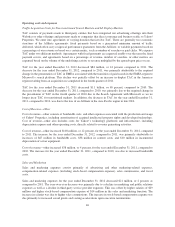Yahoo 2012 Annual Report Download - page 51
Download and view the complete annual report
Please find page 51 of the 2012 Yahoo annual report below. You can navigate through the pages in the report by either clicking on the pages listed below, or by using the keyword search tool below to find specific information within the annual report.Adjusted EBITDA. Adjusted EBITDA is a non-GAAP financial measure defined as net income attributable to
Yahoo! Inc. before taxes, depreciation, amortization of intangible assets, stock-based compensation expense,
other income, net (which includes interest), earnings in equity interests, net income attributable to noncontrolling
interests and certain gains, losses, and expenses that we do not believe are indicative of our ongoing results.
We present adjusted EBITDA because the exclusion of certain gains, losses, and expenses facilitates
comparisons of the operating performance of our Company on a period to period basis. Adjusted EBITDA has
limitations as an analytical tool and should not be considered in isolation or as a substitute for results reported
under GAAP. These limitations include: adjusted EBITDA does not reflect tax payments and such payments
reflect a reduction in cash available to us; adjusted EBITDA does not reflect the periodic costs of certain
capitalized tangible and intangible assets used in generating revenues in our businesses; adjusted EBITDA does
not include stock-based compensation expense related to our workforce; adjusted EBITDA also excludes other
income, net (which includes interest), earnings in equity interests, net income attributable to noncontrolling
interests and certain gains, losses, and expenses that we do not believe are indicative of our ongoing results, and
these items may represent a reduction or increase in cash available to us. Adjusted EBITDA is a measure that
may be unique to us, and therefore it may not enhance the comparability of our results to other companies in our
industry. Management compensates for these limitations by also relying on the comparable GAAP financial
measure of net income attributable to Yahoo! Inc., which includes taxes, depreciation, amortization, stock-based
compensation expense, other income, net (which includes interest), earnings in equity interests, net income
attributable to noncontrolling interests and the other gains, losses and expenses that are excluded from adjusted
EBITDA.
Free Cash Flow. Free cash flow is a non-GAAP financial measure defined as net cash provided by (used in)
operating activities (adjusted to include excess tax benefits from stock-based awards), less acquisition of property
and equipment, net and dividends received from equity investees.
We consider free cash flow to be a liquidity measure which provides useful information to management and
investors about the amount of cash generated by the business after the acquisition of property and equipment,
which can then be used for strategic opportunities including, among others, investing in our business, making
strategic acquisitions, strengthening the balance sheet, and repurchasing stock. A limitation of free cash flow is
that it does not represent the total increase or decrease in the cash balance for the period. Management
compensates for the limitation of free cash flow by also relying on the net change in cash and cash equivalents as
presented in our consolidated statements of cash flows prepared in accordance with GAAP which incorporates all
cash movements during the period.
Significant Transactions
Initial Repurchase of Alibaba Group Holding Limited Ordinary Shares
On September 18, 2012 (the “Repurchase Closing Date”), Alibaba Group Holding Limited (“Alibaba Group”)
repurchased (the “Initial Repurchase”) 523 million of the 1,047 million ordinary shares of Alibaba Group
(“Shares”) owned by us. The Initial Repurchase was made pursuant to the terms of the Share Repurchase and
Preference Share Sale Agreement entered into by Yahoo! Inc., Alibaba Group and Yahoo! Hong Kong Holdings
Limited, a Hong Kong corporation and wholly-owned subsidiary of Yahoo! Inc. (“YHK”) on May 20, 2012 (as
amended on September 11, 2012, the “Repurchase Agreement”). We received $13.54 per Share, or
approximately $7.1 billion in total consideration, for the 523 million Shares sold to Alibaba Group.
Approximately $6.3 billion of the consideration was received in cash and $800 million was received in Alibaba
Group preference shares (the “Alibaba Group Preference Shares”). This Initial Repurchase resulted in a pre-tax
gain of approximately $4.6 billion for the year ended December 31, 2012 which is included in other income, net
on our consolidated statements of income.
On the Repurchase Closing Date, Alibaba Group paid us $550 million in satisfaction of certain future royalty
payments under our existing Technology and Intellectual Property License Agreement (“TIPLA”) with Alibaba
Group. In addition, certain existing contractual limitations on our ability to compete in the People’s Republic of
China were terminated.
37
























